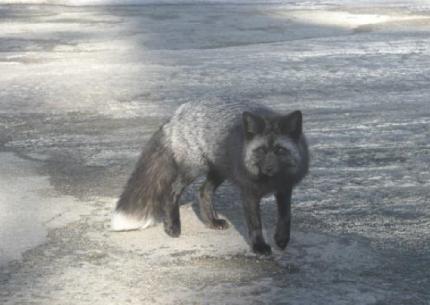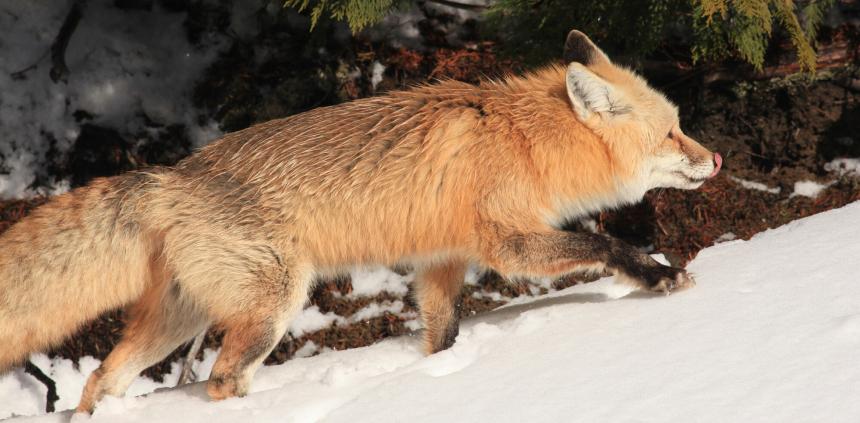Moderate-
High
The Cascade red fox is a Washington endemic subspecies that occupies alpine and subalpine habitats in the southern Cascade Mountain Range. Although there have been numerous surveys of habitats considered suitable for Cascade red foxes and a Cascade red fox was detected near Steven’s Pass (via DNA) in 2018, no resident population is currently known to exist north of the Interstate 90 corridor. Climate change could reduce the availability of habitat for this species.
Description and Range
Physical description
The Cascade red fox is a subspecies of red fox. Cascade red foxes commonly occur in three color phases: red, cross, and silver/black. All three phases have been reported within a single litter of pups.
Ecology and life history
The Cascade red fox occurs only in alpine and subalpine habitats in montane environments of the Cascade Range in Washington. Subalpine meadows, parklands, and open forests are primary habitats. The species avoids wet, dense forests of the westside Cascades and tends to prefer the open, drier subalpine forests on the east side of the Cascade crest.

Seasonal home ranges for this species vary in size from one to four square miles.
These foxes are prey generalists and prey upon a variety of small and mid-sized mammals, insects, fruits, birds, and carrion. Pocket gophers, voles, and snowshoe hares are the most common mammalian prey.
Geographic range
The Cascade red fox is known to occupy the high elevation habitats of southern Cascades. Based on surveys and observations since 2005, there are concentrations of recent verifiable detections in the vicinity of Mt. Adams, Indian Heaven Wilderness Area, Goat Rocks Wilderness Area, and Mt. Rainer National Park. Survey efforts in the North Cascades have not detected any populations of Cascade red foxes, however, a single Cascade red fox was detected near Steven’s Pass in 2018.
Overall population size and trend are unknown. Available evidence suggests that some subpopulations in the South Cascades may be small and/or isolated.
For worldwide distribution of Cascade red fox and other species' information, check out NatureServe Explorer.
Climate vulnerability
Sensitivity to climate change
Moderate-
High
The Cascade red fox is presumably adapted to colder climates and is restricted to subalpine parkland, high elevation meadows, and upper montane forest. The overall sensitivity of this subspecies to climate change is likely driven by its dependence on these colder, high elevation habitats. Warmer temperatures and reduced snowpack may negatively impact this subspecies by promoting forest encroachment into suitable parkland and meadows and/or facilitating movement of coyotes (a potential competitor and predator) into the range of Cascade red foxes. However, altered fire regimes and increased forest insect and tree disease outbreaks could benefit these foxes by reducing or preventing forest encroachment into high elevation open habitats.
Exposure to climate change
Moderate-
High
- Increased temperatures
- Reduced snowpack
- Altered fire regimes
- Increased insect and disease outbreaks
Conservation
Conservation Threats and Actions Needed
- Resource information collection needs
- Threat: Updated information is needed on distribution, abundance, and threats.
- Action Needed: Conduct periodic field surveys to determine assess occupancy trends and threat status, and to continue efforts to find a resident population in the North Cascades portion of their historical range. Conduct a status review for the species to determine if it requires protective status in the state.
- Threat: Habituation to people occurs at Mt. Rainier National Park.
- Action Needed: Determine whether habituation affects population stability for these foxes, if foxes present a threat to visitors, and management efforts by National Park Service staff could be modified to protect foxes given uncertainties in fox presence and fox-visitor interactions and foreseeable future challenges.
- Climate change (see Climate vulnerability section above for more details)
- Threat: Climate change may represent a threat from loss of higher elevation meadows and parklands.
- Action Needed: Research is needed to better determine distribution and habitat associations. Results may allow further assessment of the impacts of climate change.
- Threat: An increase in abundance of coyotes in high-elevation habitats occupied by Cascade red foxes and the threat of competition, predation and disease transmission coyotes represent to foxes.
- Action Needed: Continued surveys of occupied and suitable fox habitats to assess fox occupancy in association with habitat quality and coyote occupancy.
Resources
WDFW publications
References
Akins, J. 2014. Cascades carnivore project: 2014 spring progress report.
Aubry, K. B. 1983. The Cascade red fox: distribution, morphology, zoogeography and ecology. Dissertation, University of Washington, Seattle, Washington.
Sacks, B. N., M. J, Statham, J. D. Perrine, S. M. Wisely, and K. A. Aubry. 2010. North American montane red foxes: expansion, fragmentation, and the origin of the Sacramento Valley red fox. Conservation Genetics 11:1523-1539.


